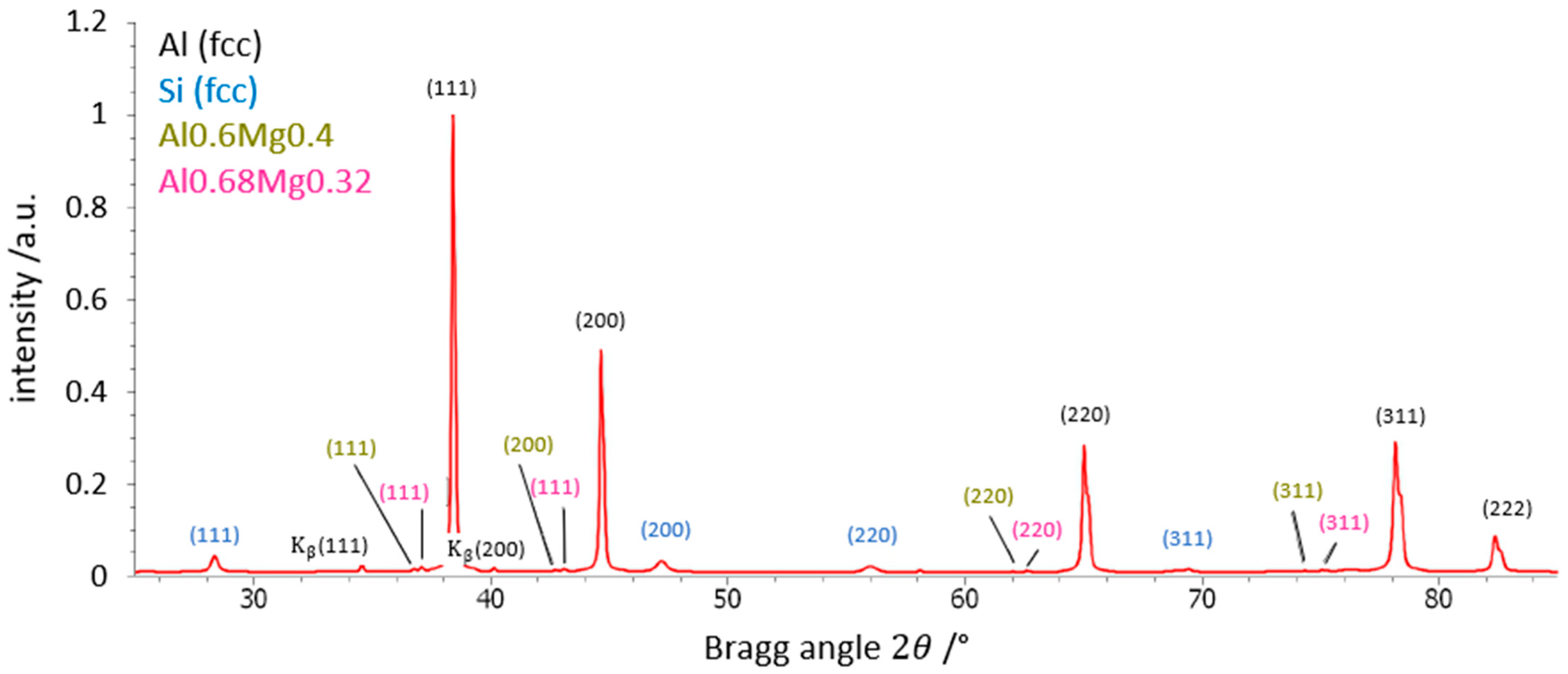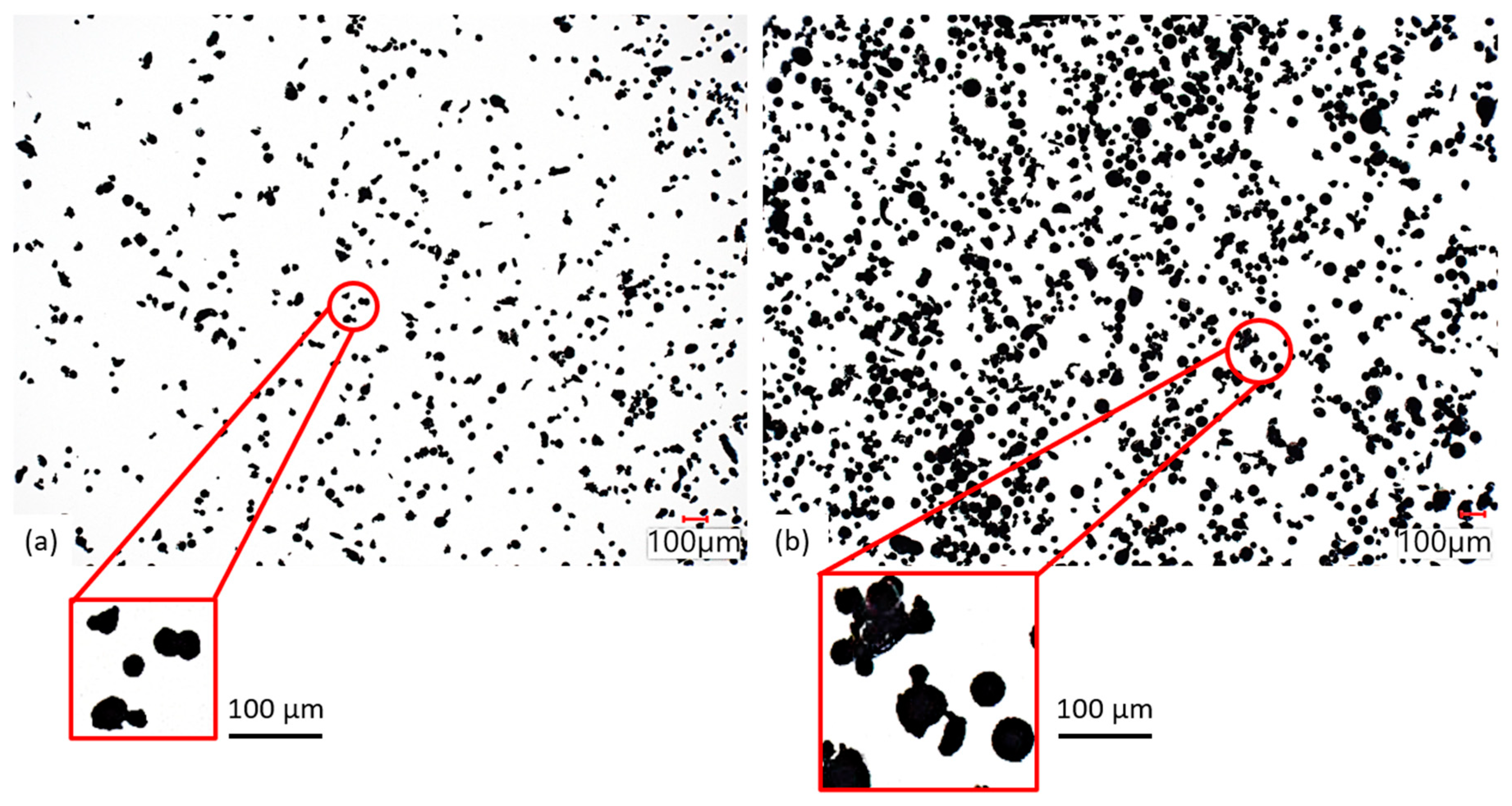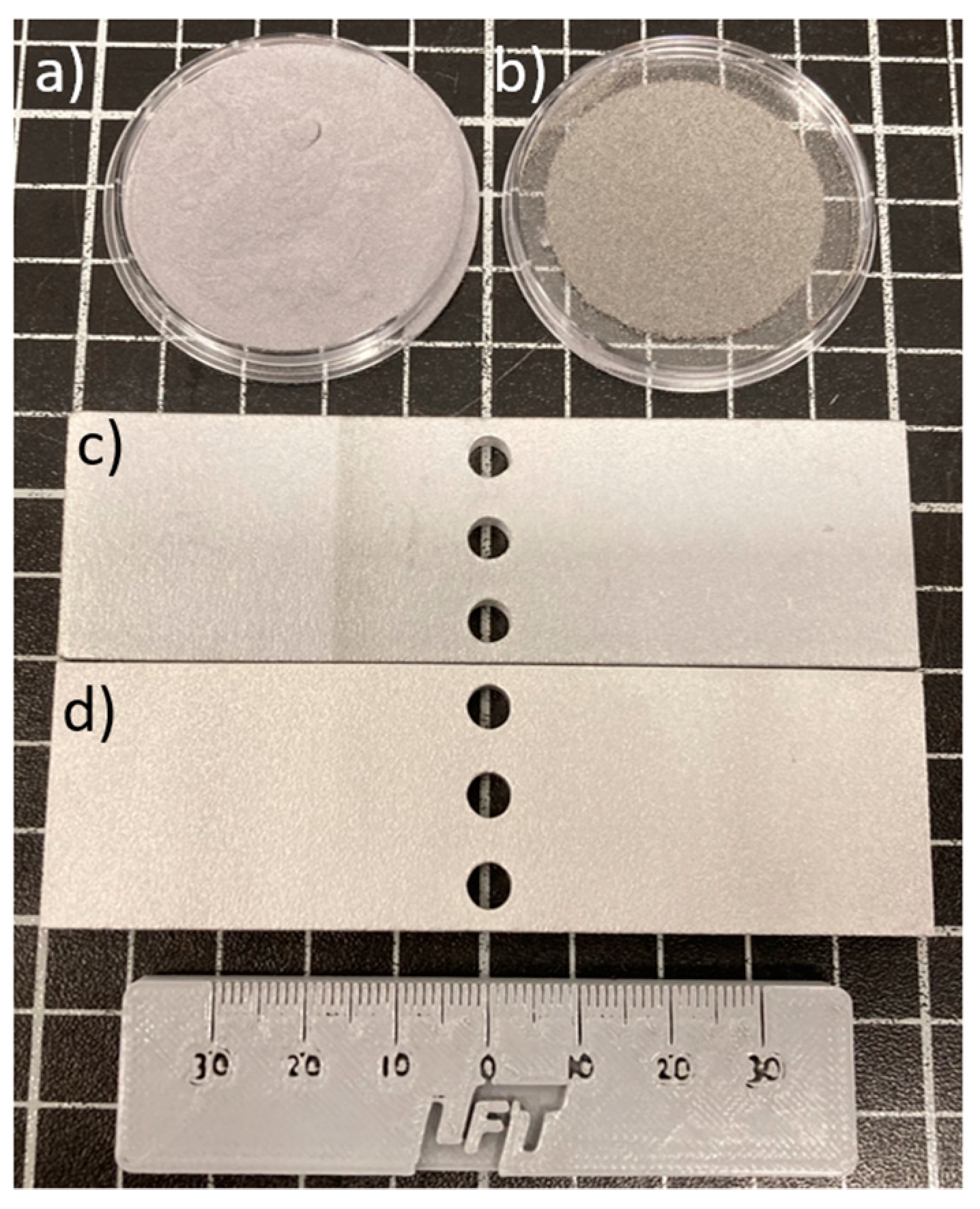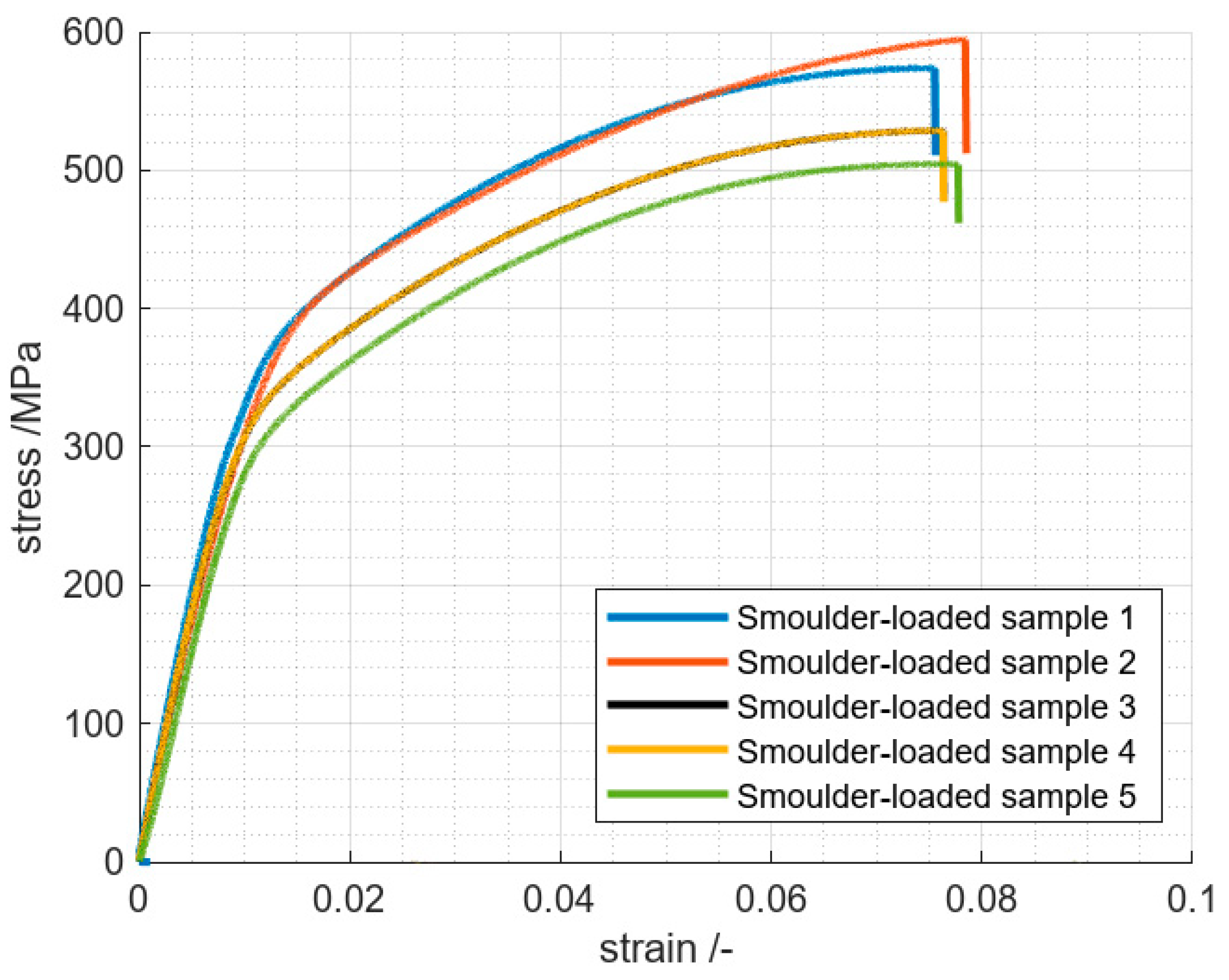Reuse of Smoulder in Laser Powder-Bed Fusion of AlSi10Mg—Powder Characterization and Sample Analysis
Abstract
:1. Introduction and State of the Art
2. Materials and Methods
2.1. L-PBF Machine and Virgin Powder
2.2. Powder Characterization Techniques
2.3. Sample Fabrication and Quality Assessment
3. Results and Discussion
3.1. Powder Characterization of Smoulder versus Virgin Powder
3.2. Part Quality of Smoulder-Containing Samples
4. Conclusions and Future Research
- The powder properties of smoulder are very similar to virgin powder. Due to larger particles, flowability and apparent density exceed values for virgin powder, this effect will decrease after sieving;
- Since all types of powder are sieved before serving in a build job, a maximum of 57% of smoulder particles can be reused. Virgin powder reaches a value of 95% according to the comparison of particle size distribution and sieving mesh size;
- The phase compositions of both powder types coincide and did not reveal the presence of oxides or other non-metallic phases that could disturb the degree of purity in a manufactured part. This does not mean a negligible oxygen content in the feedstock. As Moghimian et al. [32] pointed out, chemisorption and physical adsorption of oxygen on powder particles may introduce undesirable oxygen into the L-PBF process without being detected as oxide crystals in XRD;
- Macroscopic changes in coloration are limited to the surface only, which can be removed with sand blasting due to its thin-ness;
- The microscopic properties of smoulder-containing samples are very similar to those fabricated from virgin powder. Degree of purity analysis revealed similar porosity for both sample types which is supported by Archimedean density measurements;
- The presence of smoulder has no impact on surface core roughness or particle adhesion from the surrounding powder-bed;
- Tensile tests show a higher elongation at failure, ultimate tensile strength and yield strength than given in the material data sheet from the powder provider;
- All results point towards using smoulder as feedstock material at least once. It still remains unclear whether multiple reuses of smoulder lead to excessive oxygen contents in parts. Even in the first run the oxygen distribution may affect tensile properties and requires further investigations in future studies.
Author Contributions
Funding
Institutional Review Board Statement
Informed Consent Statement
Data Availability Statement
Acknowledgments
Conflicts of Interest
Appendix A

References and Note
- Sing, S.L.; Yeong, W.Y. Laser powder bed fusion for metal additive manufacturing: Perspectives on recent developments. Virtual Phys. Prototyp. 2020, 15, 359–370. [Google Scholar] [CrossRef]
- Yap, C.Y.; Chua, C.K.; Dong, Z.L.; Liu, Z.H.; Zhang, D.Q.; Loh, L.E.; Sing, S.L. Review of selective laser melting: Materials and applications. Appl. Phys. Rev. 2015, 2, 041101. [Google Scholar] [CrossRef]
- Godec, D.; Gonzalez-Gutierrez, J.; Nordin, A.; Pei, E.; Ureña Alcázar, J. (Eds.) A Guide to Additive Manufacturing; Springer Tracts in Additive Manufacturing; Springer International Publishing: Cham, Switzerland, 2022; ISBN 978-3-031-05862-2. [Google Scholar] [CrossRef]
- Gibson, I.; Rosen, D.; Stucker, B.; Khorasani, M. Additive Manufacturing Technologies; Springer International Publishing: Cham, Switzerland, 2021; ISBN 978-3-030-56126-0. [Google Scholar] [CrossRef]
- Sun, S.; Brandt, M.; Easton, M. Powder bed fusion processes. In Laser Additive Manufacturing; Elsevier: Amsterdam, The Netherlands, 2017; pp. 55–77. ISBN 978-0-08-100433-3. [Google Scholar] [CrossRef]
- Frazier, W.E. Metal Additive Manufacturing: A Review. J. Mater. Eng. Perform. 2014, 23, 1917–1928. [Google Scholar] [CrossRef]
- Zhang, J.; Song, B.; Wei, Q.; Bourell, D.; Shi, Y. A review of selective laser melting of aluminum alloys: Processing, microstructure, property and developing trends. J. Mater. Sci. Technol. 2019, 35, 270–284. [Google Scholar] [CrossRef]
- Maurer, O.; Herter, F.; Bähre, D. The impact of manufacturing parameters on corrosion resistance of additively manufactured AlSi10Mg-samples: A design of experiments approach. Manuf. Lett. 2022, 34, 29–33. [Google Scholar] [CrossRef]
- Hyer, H.; Zhou, L.; Park, S.; Gottsfritz, G.; Benson, G.; Tolentino, B.; McWilliams, B.; Cho, K.; Sohn, Y. Understanding the Laser Powder Bed Fusion of AlSi10Mg Alloy. Metallogr. Microstruct. Anal. 2020, 9, 484–502. [Google Scholar] [CrossRef]
- Ma, H.Y.; Wang, J.C.; Qin, P.; Liu, Y.J.; Chen, L.Y.; Wang, L.Q.; Zhang, L.C. Advances in additively manufactured titanium alloys by powder bed fusion and directed energy deposition: Microstructure, defects, and mechanical behavior. J. Mater. Sci. Technol. 2024, 183, 32–62. [Google Scholar] [CrossRef]
- Maurer, O.; Herter, F.; Bähre, D. Tolerancing the laser powder bed fusion process based on machine capability measures with the aim of process control. J. Manuf. Process. 2022, 80, 659–665. [Google Scholar] [CrossRef]
- Ferro, P.; Meneghello, R.; Razavi, S.M.J.; Berto, F.; Savio, G. Porosity Inducing Process Parameters in Selective Laser MeltedAlSi10Mg Aluminium Alloy. Phys. Mesomech. 2020, 23, 256–262. [Google Scholar] [CrossRef]
- Todaro, C.J.; Easton, M.A.; Qiu, D.; Zhang, D.; Bermingham, M.J.; Lui, E.W.; Brandt, M.; StJohn, D.H.; Qian, M. Grain structure control during metal 3D printing by high-intensity ultrasound. Nat. Commun. 2020, 11, 142. [Google Scholar] [CrossRef]
- Pragana, J.P.M.; Sampaio, R.F.V.; Bragança, I.M.F.; Silva, C.M.A.; Martins, P.A.F. Hybrid metal additive manufacturing: A state–of–the-art review. Adv. Ind. Manuf. Eng. 2021, 2, 100032. [Google Scholar] [CrossRef]
- Rauch, C.; Maurer, O.; Lang, S.-E.; Bähre, D. Serious Games in Academic Education—A Multi-dimensional Sustainability Analysis of Additive Versus Conventional Manufacturing Technologies in a Fictitious Enterprise Project. In Manufacturing Driving Circular Economy; Kohl, H., Seliger, G., Dietrich, F., Eds.; Lecture Notes in Mechanical Engineering; Springer International Publishing: Cham, Switzerland, 2023; pp. 819–826. ISBN 978-3-031-28838-8. [Google Scholar]
- Mörsdorf, S.; Neumann, D.; Mohnke, J.; Vielhaber, M. Beyond Sustainable Products—Concept for a Positive Impact Product Engineering (PIPE). Procedia CIRP 2022, 105, 19–24. [Google Scholar] [CrossRef]
- Hapuwatte, B.; Seevers, K.D.; Badurdeen, F.; Jawahir, I.S. Total Life Cycle Sustainability Analysis of Additively Manufactured Products. Procedia CIRP 2016, 48, 376–381. [Google Scholar] [CrossRef]
- Kellens, K.; Yasa, E.; Dewulf, W.; Duflou, J.R. Environmental assessment of selective laser melting and selective laser sintering. Methodology 2010, 4, 5. [Google Scholar]
- Dopler, M.; Weiß, C. Energy consumption in metal powder production. Berg. Huettenmaenn. Monatsh. 2021, 166, 2–8. [Google Scholar] [CrossRef]
- Ahmed Obeidi, M.; Mussatto, A.; Groarke, R.; Vijayaraghavan, R.K.; Conway, A.; Rossi Kaschel, F.; McCarthy, E.; Clarkin, O.; O’Connor, R.; Brabazon, D. Comprehensive assessment of spatter material generated during selective laser melting of stainless steel. Mater. Today Commun. 2020, 25, 101294. [Google Scholar] [CrossRef]
- Yang, D.; Fang, H.; Peng, Y.; Fan, J.; Huang, Y.; Wang, K.; Yan, D.; Li, D. Investigation of Spatters in Cold Metal Transfer + Pulse-Based Wire and Arc Additive Manufacturing of High Nitrogen Austenitic Stainless Steel. J. Mater. Eng. Perform. 2021, 30, 6881–6894. [Google Scholar] [CrossRef]
- Noskov, A.; Ervik, T.K.; Tsivilskiy, I.; Gilmutdinov, A.; Thomassen, Y. Characterization of ultrafine particles emitted during laser-based additive manufacturing of metal parts. Sci. Rep. 2020, 10, 20989. [Google Scholar] [CrossRef]
- Sutton, A.T.; Kriewall, C.S.; Leu, M.C.; Newkirk, J.W.; Brown, B. Characterization of laser spatter and condensate generated during the selective laser melting of 304L stainless steel powder. Addit. Manuf. 2020, 31, 100904. [Google Scholar] [CrossRef]
- Harkin, R.; Wu, H.; Nikam, S.; Quinn, J.; McFadden, S. Analysis of Spatter Removal by Sieving during a Powder-Bed Fusion Manufacturing Campaign in Grade 23 Titanium Alloy. Metals 2021, 11, 399. [Google Scholar] [CrossRef]
- Pauzon, C.; Raza, A.; Hanif, I.; Dubiez-Le Goff, S.; Moverare, J.; Hryha, E. Effect of layer thickness on spatter properties during laser powder bed fusion of Ti–6Al–4V. Powder Metall. 2023, 66, 333–342. [Google Scholar] [CrossRef]
- Keaveney, S.; Shmeliov, A.; Nicolosi, V.; Dowling, D.P. Investigation of process by-products during the Selective Laser Melting of Ti6AL4V powder. Addit. Manuf. 2020, 36, 101514. [Google Scholar] [CrossRef]
- Simonelli, M.; Tuck, C.; Aboulkhair, N.T.; Maskery, I.; Ashcroft, I.; Wildman, R.D.; Hague, R. A Study on the Laser Spatter and the Oxidation Reactions During Selective Laser Melting of 316L Stainless Steel, Al-Si10-Mg, and Ti-6Al-4V. Metall. Mater. Trans. A 2015, 46, 3842–3851. [Google Scholar] [CrossRef]
- Murray, J.W.; Speidel, A.; Spierings, A.; Marsh, I.J.; Clare, A.T. Extending powder lifetime in additive manufacturing: Chemical etching of stainless steel spatter. Addit. Manuf. Lett. 2022, 3, 100057. [Google Scholar] [CrossRef]
- Aboulkhair, N.T.; Maskery, I.; Ashcroft, I.; Tuck, C.; Everitt, N.M. The role of powder properties on the processability of Aluminium alloys in selective laser melting. In Proceedings of the Lasers in Manufacturing Conference 2015, Munich, Germany, 22–25 June 2015; p. 6. [Google Scholar]
- Weiss, C.; Munk, J.; Haefner, C.L. Investigation Towards AlSi10Mg Powder Recycling Behavior in the LPBF Process and Its Influences on Mechanical Properties. In Proceedings of the 2021 International Solid Freeform Fabrication Symposium, Virtual, 2–4 August 2021; p. 16. [Google Scholar]
- Del Re, F.; Contaldi, V.; Astarita, A.; Palumbo, B.; Squillace, A.; Corrado, P.; Di Petta, P. Statistical approach for assessing the effect of powder reuse on the final quality of AlSi10Mg parts produced by laser powder bed fusion additive manufacturing. Int. J. Adv. Manuf. Technol. 2018, 97, 2231–2240. [Google Scholar] [CrossRef]
- Moghimian, P.; Poirié, T.; Habibnejad-Korayem, M.; Zavala, J.A.; Kroeger, J.; Marion, F.; Larouche, F. Metal powders in additive manufacturing: A review on reusability and recyclability of common titanium, nickel and aluminum alloys. Addit. Manuf. 2021, 43, 102017. [Google Scholar] [CrossRef]
- Smolina, I.; Gruber, K.; Pawlak, A.; Ziółkowski, G.; Grochowska, E.; Schob, D.; Kobiela, K.; Roszak, R.; Ziegenhorn, M.; Kurzynowski, T. Influence of the AlSi7Mg0.6 Aluminium Alloy Powder Reuse on the Quality and Mechanical Properties of LPBF Samples. Materials 2022, 15, 5019. [Google Scholar] [CrossRef]
- Sun, X.; Chen, M.; Liu, T.; Zhang, K.; Wei, H.; Zhu, Z.; Liao, W. Characterization, preparation, and reuse of metallic powders for laser powder bed fusion: A review. Int. J. Extreme Manuf. 2024, 6, 012003. [Google Scholar] [CrossRef]
- SLM Solutions Material Data Sheet Al-Alloy AlSi10Mg/EN AC-43000/EN AC-AlSi10Mg 2019.
- Norm NF EN ISO 4490:2018; Metallic Powders—Determination of Flow Rate by Means of a Calibrated Funnel (Hall Flowmeter). International Organization for Standardization: Geneva, Switzerland, 2018.
- Mittellehner, M.; Danninger, H.; Gierl-Mayer, C.; Gschiel, H. Investigation of the influence of powder moisture on the spreadability using the spreading tester. Berg. Huettenmaenn. Monatsh. 2021, 166, 14–22. [Google Scholar] [CrossRef]
- EN ISO 3923-1:2018-10; Metallic Powders—Determination of Apparent Density—Part 1: Funnel Method (ISO 3923-1:2018). German Version EN ISO 3923-1:2018; International Organization for Standardization: Geneva, Switzerland, 2018. [CrossRef]
- Mahr MahrSurf Surface Texture Parameters. Available online: https://capps.mahr.com/mahr-parameter/html/english/MarSurf/MarSurf.html (accessed on 30 July 2023).
- Lam, L.P.; Zhang, D.Q.; Liu, Z.H.; Chua, C.K. Phase analysis and microstructure characterisation of AlSi10Mg parts produced by Selective Laser Melting. Virtual Phys. Prototyp. 2015, 10, 207–215. [Google Scholar] [CrossRef]
- Ghio, E.; Cerri, E. Additive Manufacturing of AlSi10Mg and Ti6Al4V Lightweight Alloys via Laser Powder Bed Fusion: A Review of Heat Treatments Effects. Materials 2022, 15, 2047. [Google Scholar] [CrossRef] [PubMed]
- Sert, E.; Schuch, E.; Öchsner, A.; Hitzler, L.; Werner, E.; Merkel, M. Tensile strength performance with determination of the Poisson‘s ratio of additively manufactured AlSi10Mg samples. Mater. Werkst. 2019, 50, 539–545. [Google Scholar] [CrossRef]
- Friedrich, H.E. (Ed.) Magnesium Technology: Metallurgy, Design Data, Applications; Springer: Berlin/Heidelberg, Germany, 2006; ISBN 978-3-540-20599-9. [Google Scholar]






| Elements | Al | Si | Fe | Mg | Mn | Ti | Zn | Others Each |
|---|---|---|---|---|---|---|---|---|
| Wt.% | Bal. | 9–11 | 0.55 | 0.45 | 0.45 | 0.15 | 0.10 | 0.05 |
| Parameter | Powder Layer Thickness | Laser Power | Scan Speed | Hatch Distance | Substrate Heating | Scan Strategy | Shielding Gas |
|---|---|---|---|---|---|---|---|
| Value | 30 µm | 250 W | 1650 | 0.13 mm | 423 K | Hatch | Argon |
| Powder Property | Smoulder | Virgin Powder | State |
|---|---|---|---|
| Relative moisture content/% | Not sieved | ||
| (EN ISO 4490) | |||
| (EN ISO 3923) | |||
| /µm | |||
| /µm | |||
| /µm | |||
| ) |
| Roughness Type | Smoulder-Containing Region | Region from Virgin Powder |
|---|---|---|
| Core roughness /µm | Building direction: Interlayer roughness: | Building direction: Interlayer roughness: |
| Peak core roughness /µm | Building direction: Interlayer roughness: | Building direction: Interlayer roughness: |
| Tensile Property | Smoulder-Containing Samples | Material Data Sheet from Powder Provider [35] | Ghio and Cerri [41] at Similar Process Parameters | Sert et al. [42] |
|---|---|---|---|---|
| Elongation at failure/- | ||||
| Ultimate tensile strength/MPa | ||||
| Yield strength at 0.2% plastic strain/MPa |
Disclaimer/Publisher’s Note: The statements, opinions and data contained in all publications are solely those of the individual author(s) and contributor(s) and not of MDPI and/or the editor(s). MDPI and/or the editor(s) disclaim responsibility for any injury to people or property resulting from any ideas, methods, instructions or products referred to in the content. |
© 2024 by the authors. Licensee MDPI, Basel, Switzerland. This article is an open access article distributed under the terms and conditions of the Creative Commons Attribution (CC BY) license (https://creativecommons.org/licenses/by/4.0/).
Share and Cite
Maurer, O.; Jacob, H.; Bähre, D. Reuse of Smoulder in Laser Powder-Bed Fusion of AlSi10Mg—Powder Characterization and Sample Analysis. Powders 2024, 3, 154-167. https://doi.org/10.3390/powders3020010
Maurer O, Jacob H, Bähre D. Reuse of Smoulder in Laser Powder-Bed Fusion of AlSi10Mg—Powder Characterization and Sample Analysis. Powders. 2024; 3(2):154-167. https://doi.org/10.3390/powders3020010
Chicago/Turabian StyleMaurer, Oliver, Heiko Jacob, and Dirk Bähre. 2024. "Reuse of Smoulder in Laser Powder-Bed Fusion of AlSi10Mg—Powder Characterization and Sample Analysis" Powders 3, no. 2: 154-167. https://doi.org/10.3390/powders3020010







